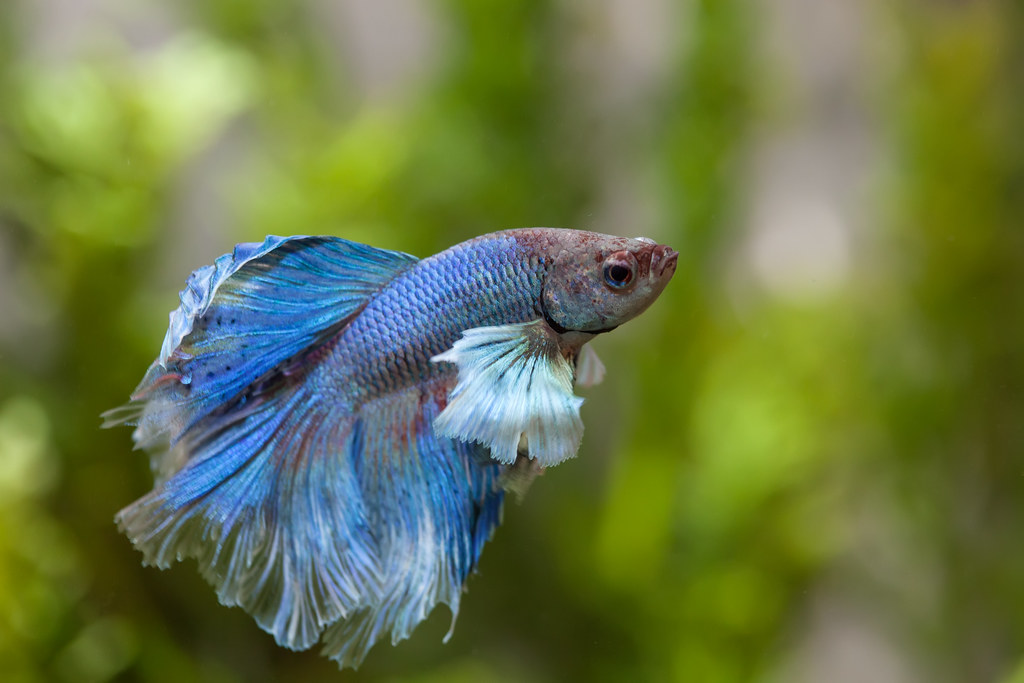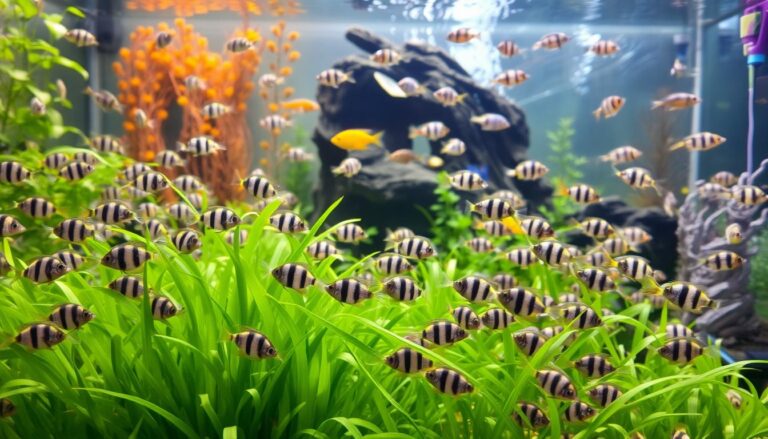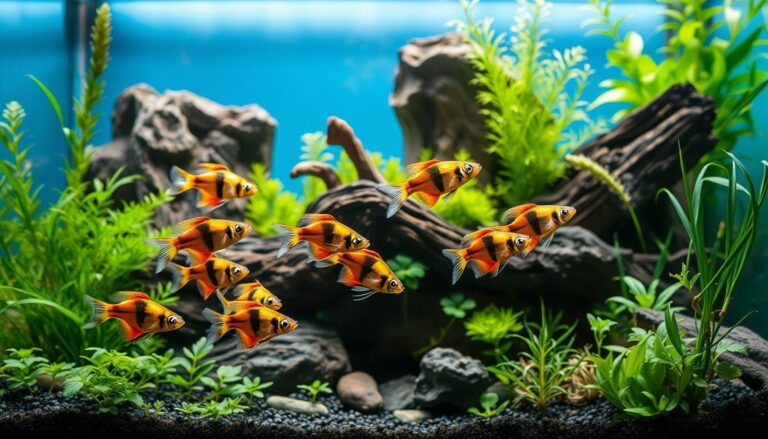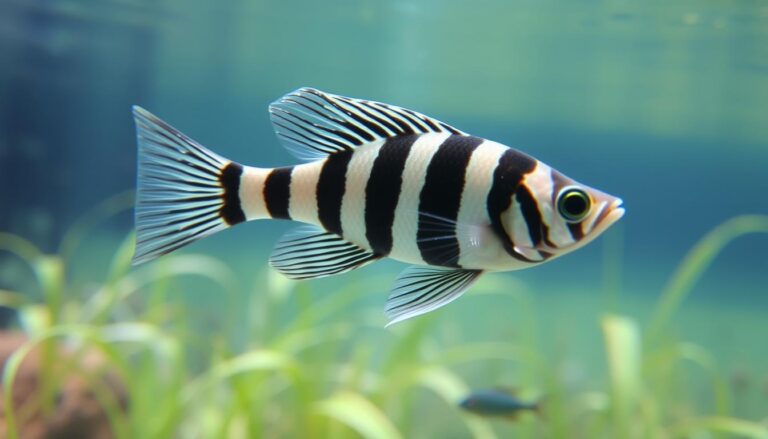Discover the Perfect Betta Fish Tank Size for Your Betta
Is a 5-gallon tank really enough space for your betta fish to thrive—or is it time to rethink what your finned friend truly needs?

Betta fish tank size isn’t just about numbers. It’s about creating a healthy home that matches their natural habits. Many owners assume small tanks suffice, but the right space ensures vibrant colors, active swimming, and long-term well-being. This guide cuts through myths to show exactly how to pick a size that supports your betta’s life underwater.
From water quality to stress reduction, every detail matters. Let’s uncover why choosing the wrong betta fish tank size could harm your pet’s health—and how to avoid common mistakes.
Table of Contents
Key Takeaways
- Minimum recommended tank size starts at 5 gallons but often needs adjustment.
- Space affects water quality and disease prevention.
- Bettas need room to explore to stay mentally stimulated.
- Myths about small tanks can lead to hidden health risks.
- Proper sizing boosts lifespan and color vibrancy.
Introduction to Betta Fish Tank Sizing
Betta fish do best in spaces that match their natural habits. The right tank size is key for their health and happiness. A bad choice can stress them out or make them sick.
Why Tank Size Matters
Small tanks can trap harmful toxins like ammonia. This can hurt their immune system. PetMD’s guide says cramped spaces can cause stress and infections.
The best tank size helps avoid these problems. It lets water circulate well and keeps toxins down.
Overview of Betta Fish Needs
These fish need environments that feel like their wild homes. They need:
- Enough space to swim: At least 1 gallon for one betta.
- Stable water temperature between 78°F and 82°F.
- Plants or driftwood for hiding spots.
Female bettas need 15+ gallons in groups, and males 10+ gallons to avoid fighting. The right tank size keeps them active and calm. It also lets them show their natural territorial behavior without fighting with other fish.
betta fish tank size
Many believe betta fish do well in small spaces, but this isn’t true. In the wild, betta fish live in shallow, green waters with up to 11 gallons of space, as a 2000 study found. Experts like PNW Bettas say a minimum of 5 gallons is best for home tanks. This balance makes care easier and keeps the fish happy.
When choosing a betta fish tank, shape and size are crucial. Here’s what you need to know:
- Length over height: Long, wide tanks let bettas swim horizontally.
- Surface access: Shallow designs help their labyrinth breathing.
- Water stability: Larger tanks reduce toxin spikes between cleanings.

| Tank Size | Pros | Cons |
|---|---|---|
| 5 Gallons | Easy maintenance, affordable | Limited space for plants |
| 10+ Gallons | Healthier water, activity space | Higher upfront cost |
Always choose horizontal space over vertical. A 10-inch long 5-gallon tank is better than a tall 5-gallon vase. Tanks over 10 gallons are best for long-term health. Remember, the size of the tank isn’t just about gallons. It’s about giving your betta fish room to explore and thrive.
Essential Tank Setup for Betta Health
Setting up a good home for betta fish is more than just the size. You need proper filtration, clean water, and safe decorations. Follow these steps to make sure your betta has a healthy environment.
Selecting the Right Filtration
Find a filter that moves water softly without stressing your betta. The Aquatop Silent Premium or Penn-Plax Bio-Wheel are great choices. Stay away from strong filters. If needed, use a sponge filter.
Make sure intake tubes are not near where your betta swims. This keeps currents from being too strong.
Maintaining Ideal Water Conditions
Check the water weekly with an API Freshwater Master Test Kit. You want 0 ppm ammonia/nitrite, nitrates under 20 ppm, and pH between 6.5–7.5. Also, replace 25% of the water every week to keep it stable.
Lighting and Decoration Considerations
Give your betta 8–12 hours of soft light each day. Use live plants like java fern or silk ones for hiding. Add smooth rocks and driftwood, but avoid sharp decorations. Make sure there’s enough room for your betta to swim without getting hurt.
Analyzing Case Studies: Betta Tank Size in Action
Real-life examples show how optimal tank size for betta fish impacts their health. Let’s explore two scenarios to see why size matters.

| Case Study | Tank Size | Setup | Outcome |
|---|---|---|---|
| Case 1 | 2 gallons | Small bowl, no plants | Fish showed fin rot and stress signs |
| Case 2 | 5 gallons | Plants, filter, open space | Active swimming, no health issues |
In Case 1, a 2-gallon tank caused stress. Bettas need room to swim. Case 2’s 5-gallon setup with plants and a filter promoted healthy behavior. These examples highlight the optimal tank size for betta fish as at least 5 gallons. Plants and space reduce stress, while cramped tanks lead to health declines.
- 5+ gallons: Ideal for swimming and oxygen flow
- Plants: Help mimic natural habitats
- Filters: Keep water clean without strong currents
These studies show that proper sizing isn’t just about gallons—it’s about balancing space with a safe environment. Always prioritize the optimal tank size for betta fish to ensure long-term health.
Designing Your Betta’s Habitat

Creating a great betta habitat is all about finding the right balance. You need enough space, safety, and things to do. Let’s look at the important parts to make a healthy and fun home for your betta.
Optimal Tank Dimensions
Choosing the right tank size is key. Go for at least 5 gallons, but bigger tanks (10+ gallons) are even better. Stay away from tall, narrow tanks because betta fins need room to move horizontally. A rectangular tank is best for natural swimming.
Substrate and Plants
- Substrate: Pick smooth gravel or fine sand to keep your betta’s fins safe. Dark substrates make their colors pop.
- Plants: Live plants like java fern or anubias are great. They help keep the water clean and give your betta places to hide. You can also use fake plants, but make sure they’re soft and flexible.
Flow and Space Optimization
Use driftwood or ceramic caves to make different areas in the tank. Place plants in calm spots and leave open areas for swimming. Don’t get strong filters because betta fish like calm water.
Decorations should cover 60-70% of the tank’s surface to stop your betta from jumping. Floating plants like water lettuce provide shade and safety. Always watch your betta for signs of stress like hard breathing or fins held tight.
Review of Recommended Tank Size for Betta Fish
Experts say a minimum of 5 gallons is key for betta fish tanks. The American Betta Society stresses the need for space for movement and oxygen. Let’s look at the main points from UKAPS forums and aquatic care studies.
- A 600mm (≈24-inch) tank divided into three sections offers balance between space and safety.
- Sponge filters with gentle airflow, paired with a central heater, stabilize water conditions without stressing fish.
- Aim for tanks 10 gallons or larger for long-term health, avoiding cramped spaces that trap waste.
Proper betta tank size guidelines also involve hiding spots and plant coverage. Tanks under 5 gallons need daily checks to avoid toxin buildup. Always put water quality first—small tanks need strict care routines.
Remember, betta fish do best in environments that mimic their natural habitats. Follow these standards to give your betta a stress-free, spacious home.
How to Choose Betta Fish Tank Size for Optimal Wellbeing
Choosing the recommended tank size for betta fish is all about finding the right balance. A 5-gallon tank is a good starting point. But, it’s the width that really matters. Here’s how to set up the best space for your betta.
“Width is life—betta fish thrive in tanks that let them glide, not just swim in circles.”
Factors Influencing Tank Size
- Width over volume: Prioritize tanks at least 12 inches wide to mimic natural habitats.
- Activity level: Active bettas need longer tanks for exploration.
- Equipment space: Filters and heaters require room, so avoid tanks under 5 gallons.
Environmental and Behavioral Cues
Keep an eye on your betta’s behavior. If it stays in one spot, it might need more space. Fantasea Aquariums says that 5-gallon tanks work best when paired with proper care. Look for calmness—betta flaring at tank walls can signal stress from cramped conditions.
Always think about your betta’s personality. Shy fish may need plants and hiding spots in wider tanks. The right size supports health, reducing ammonia spikes and stress-related illnesses. Start with the recommended tank size for betta fish, then adjust based on daily observations.
Applying Betta Fish Tank Size Chart for Accurate Sizing
A betta fish tank size chart makes picking the right tank easy. First, match your betta’s lifestyle to the chart’s advice. For example, a single giant betta needs at least 10 gallons. Communities need 20+ gallons plus 5 gallons for each extra female. Here’s how to do it:
Interpreting the Chart Correctly
- Look at the chart for the minimum tank size based on your betta’s type.
- Remember to add space for plants, decor, and hiding spots in your tank layout.
- Make sure your water temperature (77-82°F) and pH (6.8-7.2) match your tank’s setup.
Adjusting for Individual Betta Needs
Bettas do best in environments that match their behavior. A shy betta might need more hiding spots. An active betta will enjoy open swimming areas. Use the chart as a starting point, then add plants or rocks for personal touches. Watch your betta’s behavior—restlessness or stress means they need a bigger or better tank.
Check out Thailand Betta Fish’s guide for practical tips. Regular water tests and weekly changes keep your tank stable, even as you adjust the chart suggestions.
Conclusion
Learning about Betta fish tank size begins with their natural homes. Wild Betta mahachaiensis live in small spaces like palm bracts, as Amazonas Magazine’s research shows. This matches the needs of domestic Betta splendens, which do well in 5-gallon tanks with proper care.
The secret is finding the right balance. This means clean water, gentle filters, and safe decorations like plants or driftwood.
Every Betta is different, so you need to adjust their care based on their behavior. Follow the tips in this guide to create a stable home. Regular water checks and avoiding overcrowding are key to their long-term health.
Whether you have a 2.5 or 10-gallon tank, focus on consistent care and a good habitat. By matching their natural instincts with your care, you’ll help your Betta thrive. Thoughtful planning makes a big difference.
FAQ
What is the best tank size for betta fish?
For betta fish, a tank of at least 5 gallons is best. A small bowl might seem easy, but a bigger tank keeps the water stable. This reduces stress for your betta.
What are the betta fish tank requirements I should know about?
Betta fish need a tank that’s big enough. It should have a secure lid to stop them from jumping. Also, a heater to keep the water warm (76-82°F) and good filtration for clean water.
How can I determine the optimal tank size for betta fish?
The best tank size for betta fish depends on a few things. Like how active they are and if they’ll be alone or with others. Generally, bigger tanks are better because they keep the water stable.
Are there betta tank size guidelines I should follow?
Yes, there are guidelines for betta tank sizes. A minimum of 5 gallons is recommended for one betta. For multiple bettas or other fish, you’ll need an even bigger tank to prevent fights.
What should I consider when choosing betta fish tank size?
Think about your betta’s behavior and what you want to do with the tank. Like if you’re breeding or keeping a community tank. Also, consider how much space you have. Bigger tanks usually mean better filtration and less stress for your betta.
How can I use a betta fish tank size chart?
A betta fish tank size chart can help you pick the right tank. Look at the chart and adjust the sizes based on your betta’s needs. Like their activity level and what they like in their environment.
Do bettas need any specific decorations in their tanks?
Yes! Decorations like plants and hiding spots make their tank better. They help your betta feel safe. Just make sure the decorations are smooth and won’t hurt your betta.
Can I use a smaller tank for my betta fish?
You can use a smaller tank, but it’s not the best choice. Tanks under 5 gallons can have unstable water and stress your betta. This can hurt their health and shorten their life.







